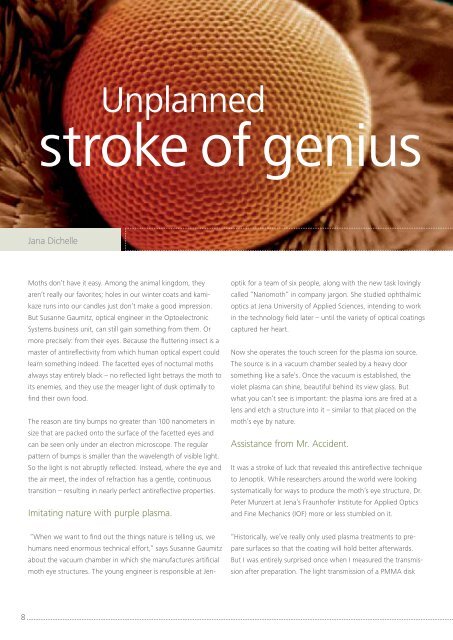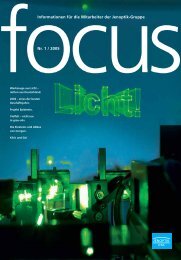normal - Jenoptik AG
normal - Jenoptik AG
normal - Jenoptik AG
Create successful ePaper yourself
Turn your PDF publications into a flip-book with our unique Google optimized e-Paper software.
8<br />
Jana Dichelle<br />
Unplanned<br />
stroke of genius<br />
Moths don’t have it easy. Among the animal kingdom, they<br />
aren’t really our favorites; holes in our winter coats and kamikaze<br />
runs into our candles just don’t make a good impression.<br />
But Susanne Gaumitz, optical engineer in the Optoelectronic<br />
Systems business unit, can still gain something from them. Or<br />
more precisely: from their eyes. Because the fluttering insect is a<br />
master of antireflectivity from which human optical expert could<br />
learn something indeed. The facetted eyes of nocturnal moths<br />
always stay entirely black – no reflected light betrays the moth to<br />
its enemies, and they use the meager light of dusk optimally to<br />
find their own food.<br />
The reason are tiny bumps no greater than 100 nanometers in<br />
size that are packed onto the surface of the facetted eyes and<br />
can be seen only under an electron microscope. The regular<br />
pattern of bumps is smaller than the wavelength of visible light.<br />
So the light is not abruptly reflected. Instead, where the eye and<br />
the air meet, the index of refraction has a gentle, continuous<br />
transition – resulting in nearly perfect antireflective properties.<br />
Imitating nature with purple plasma.<br />
“When we want to find out the things nature is telling us, we<br />
humans need enormous technical effort,” says Susanne Gaumitz<br />
about the vacuum chamber in which she manufactures artificial<br />
moth eye structures. The young engineer is responsible at Jen-<br />
optik for a team of six people, along with the new task lovingly<br />
called “Nanomoth” in company jargon. She studied ophthalmic<br />
optics at Jena University of Applied Sciences, intending to work<br />
in the technology field later – until the variety of optical coatings<br />
captured her heart.<br />
Now she operates the touch screen for the plasma ion source.<br />
The source is in a vacuum chamber sealed by a heavy door<br />
something like a safe’s. Once the vacuum is established, the<br />
violet plasma can shine, beautiful behind its view glass. But<br />
what you can’t see is important: the plasma ions are fired at a<br />
lens and etch a structure into it – similar to that placed on the<br />
moth’s eye by nature.<br />
Assistance from Mr. Accident.<br />
It was a stroke of luck that revealed this antireflective technique<br />
to <strong>Jenoptik</strong>. While researchers around the world were looking<br />
systematically for ways to produce the moth’s eye structure, Dr.<br />
Peter Munzert at Jena’s Fraunhofer Institute for Applied Optics<br />
and Fine Mechanics (IOF) more or less stumbled on it.<br />
“Historically, we’ve really only used plasma treatments to prepare<br />
surfaces so that the coating will hold better afterwards.<br />
But I was entirely surprised once when I measured the transmission<br />
after preparation. The light transmission of a PMMA disk
















